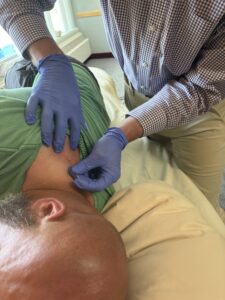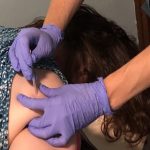Dry Needling Technique
Dry Needling, also known as Intramuscular Trigger Point Release, is an effective method of treating deep-seated and chronic areas of myofascial tension as well as acute injuries. The technique was developed by cardiologist Janet Travell, MD, who was also President John F. Kennedy’s personal physician. She discovered that muscle knots, or trigger points, could be treated and pain would go away.
What is Dry Needling Technique?
 This treatment uses a sterile, individually wrapped, solid filament needle which is inserted into the muscle and directed at the myofascial trigger point. There is no medication or solution injected into the muscle, so this may be considered a natural treatment.
This treatment uses a sterile, individually wrapped, solid filament needle which is inserted into the muscle and directed at the myofascial trigger point. There is no medication or solution injected into the muscle, so this may be considered a natural treatment.
Is Dry Needling similar to acupuncture?
The only similarity is the two procedures use the same type of solid needle. In acupuncture, the needle is inserted into the subcutaneous tissue, and not deeper. The needle is strategically placed along lines of energy called meridians. These are rooted in Eastern medicine and dry needling does not follow this. Instead, the needle is inserted directly to the muscle layer, aiming for the “knot” or trigger point.
What conditions can be treated with Dry Needling?
Dry needling can be used to address a variety of muscle and joint problems. Since tight or spasmed muscles are a contributing and limiting factor for many conditions, dry needling is indicated to alleviate this tension, and thereby progress the patient through rehabilitation. Such conditions include, but are not limited to neck, back and shoulder pain, piriformis syndrome, plantar fasciitis, tennis elbow, carpal tunnel, golfer’s elbow, headaches, migraines, jaw pain and Temporal Mandibular Joint pain or Temporal Mandibular Disorder (TMD), leg pain, sciatica, hamstring or calf strains, patellofemoral syndrome.
Is the procedure painful?
Most patients do not feel the insertion of the needle. When the therapist gets the needle right on the trigger point, a “twitch response” is elicited. This is brief, less than a second, where the muscle involuntary twitches or jumps. Some patient describe this as a small shock, some like a cramping sensation like when you get a charlie horse. The twitch response is a desirable reaction. It is thought to be caused by “puncturing” the membrane housing the acidic chemicals that make up a trigger point. The twitch then is the membrane re-balancing, and restoring to normal balance, or neutral pH levels. Most clients are mildly sore in the area for about 24 hours.
What side effects can I expect after treatment?
You may be sore for 1-2 days. Ice is recommended initially. Drink plenty of water to better re-balance fluids and chemical concentrations that were just disrupted. Even though you may be sore, almost immediately most people notice improved movement and decreased muscle tension in the area treated.
Once I feel better, do I need to come back for treatment?
You should talk to your therapist about your personal situation. Most muscles that are under more constant pressure – from gravity, stress, occupational activity – would benefit from regular periodic treatment. “Tune-ups” may be recommended to prevent the condition from returning.

